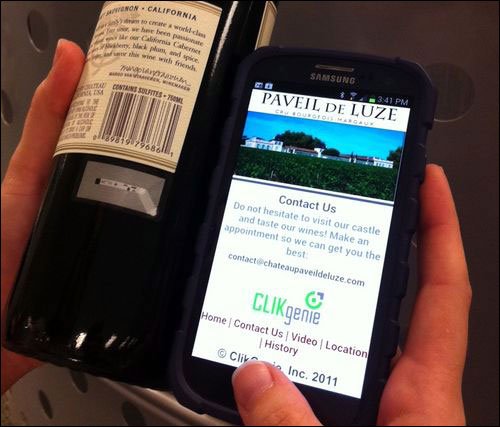FineLine, a provider of ticketing and mobile solutions for retailers and manufacturers, has launched a Near Field Communication (NFC) RFID tag and label service bureau. The solution allows companies to order tags online. Each tag is encoded with an ID number that, when read by the phone, causes the handset to display a Web page or play a video, or to trigger some other action, such as sending an SMS text message to that phone.
FineLine is already taking orders from brands and other companies, and is demonstrating how the technology works in conjunction with mobile phones to authenticate goods, as well as provide consumers with information about a particular tagged item.

FineLine has been providing price labels for retailers for approximately 12 years. After receiving an order placed on its Web site, the company prints and ships the labels—typically, within 48 hours. Earlier this year, it began providing EPC Gen 2 ultrahigh-frequency (UHF) RFID tags and labels to retailers and goods suppliers, encoding each RFID inlay with a unique number via the Multi-vendor Chip-based Serialization (MCS) scheme devised in March 2012 by three leading suppliers of EPC Gen 2 UHF microchips (see Three RFID Chip Makers Agree on Serialization Approach).
At that time, the company began looking into providing high-frequency (HF) NFC RFID labels as well. Although most mobile phones are currently not equipped with NFC readers, says George Hoffman, FineLine’s CEO, a majority of phones are expected to do so over the next five years. According to a Frost & Sullivan study published in January 2011, at least 53 percent of phones will be NFC-enabled by 2015. FineLine is now offering its NFC Service Bureau to provide NFC labels, each encoded with an ID number that, when interrogated by the phone, will trigger a specific action, such as directing the phone to a Web page or video. The labels are also available with other options, such as data encryption, as well as larger memory capacity using an array of different chips and inlays.
FineLine also offers five other alternatives that can be linked to a tag’s ID: sending an SMS message to that phone, containing text about a product or item; navigating the phone to a specific street address, such as a store where that product can be viewed or purchased; launching a phone call (to a business, for example); or an advanced solution enabling FineLine’s customers to type in text or a protocol for the NFC Data Exchange Format (NDEF) record type that they want to create themselves. FineLine is employing mobile technology provided by ClikGenie. Consumers equipped with an NFC-enabled phone can simply hold the phone near the product’s label, as instructed. The phone will then be directed to a hosted ClikGenie application that, based on the tag’s ID number, will cause the phone to display a Web site or play videos depicting the product in use or being manufactured, or other relevant information about the item.According to Hoffman, FineLine sells labels made with Smartrac tags containing NXP Semiconductors‘ NTAG203 chips, such as Smartrac’s BullsEye, though tag type varies according to each customer’s needs.
What’s more, FineLine can provide software service on a cloud-based server that helps a business monitor how often a tag is scanned, as well as when and where this occurs.
The most common application, Hoffman predicts, will be ClikSecure, a ClikGenie mobile application for brand protection and authentication. Brand owners of high-value products can have an NFC label attached to that product, such as a handbag or a bottle of wine. Brands often send auditors into stores, ports, loading docks and customs areas, in order to confirm products’ authenticity in the supply chain, or as the goods are sold. By using NFC technology, the company can simply provide those auditors with NFC-enabled phones, such as Google‘s Nexus S model. An individual can then place his or her mobile phone within read range (a few inches) of the products, and determine whether that product has a valid NFC RFID tag. In this way, the auditor can ensure that the product is authentic.
The read data can also be saved on FineLine’s cloud-based software and be provided to brand management, to collect information indicating which products the auditors have checked, and in which part of the world, based on GPS data from the phone. Smartrac also intends to market the ClikSecure mobile app to its customers for brand-protection applications. Details regarding how the app will be marketed have yet to be decided.
Since launching its NFC service bureau last month, FineLine has received orders from a major brand in Europe that is interested in piloting the technology for the purpose of authentication. Several U.S. phone carriers plan to utilize the tags to provide URL links to consumers wishing to view how a phone’s functions can be used. FineLine reports that it will also supply NFC labels to a product display company that will be tagging its kiosks. In the latter scenario, the label will include an NFC tag and a QR code so that a user can learn more about a particular product within the kiosk, by tapping his or her NFC phone or scanning the QR code.
To date, Hoffman says, the use cases “have been pretty diverse.”

